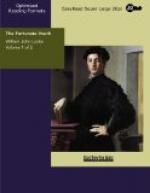The young man, sitting on an upturned wooden case, at the extreme edge of the elm tree’s shade, a slender easel before him, a litter of paraphernalia on the ground by his side, painted assiduously. Paul idly crept behind him and watched in amazement the smears of wet colour, after a second or two of apparent irrelevance, take their place in the essential structure of the drawing. He stood absorbed. He knew that there were such things as pictures. He knew, too, that they were made by hands. But he had never seen one in the making. After a while the artist threw back his head, looked at the inn and looked at his sketch. There was a hot bit of thatch at the corner near the orchard, and, below the eaves, bold shadow. The shadow had not come right. He put in a touch of burnt umber and again considered the effect.
“Confound it! that’s all wrong,” he muttered.
“It’s blue,” said Paul.
The artist started, twisted his head, and for the first time became conscious of the ragamuffin’s presence. “Oh, you see it blue, do you?” He smiled ironically.
“Ay,” said Paul, with pointing finger. “Look at it. It’s not brown, anyhow. Yon’s black inside and blue outside.”
The young man shaded his brow and gazed intently. Brilliant sunshine plays the deuce with tones. “My hat!” cried he, “you’re right. It was this confounded yellow of the side of the house.” He put in a few hasty strokes. “That better?”
“Ay,” said Paul.
The artist laid down his brush, and swung round on his box, clasping knees. “How the devil did you manage to see that when I didn’t?”
“Dun-no!” said Paul.
The young man stretched himself and lit a cigarette.
“What are yo’ doing that for, mister?” Paul asked seriously.
“That?”
“Ay,” said Paul. “You mun have a reason.”
“You’re a queer infant,” laughed the artist. “Do you really want to know?”
“I’ve asked yo’,” said Paul.
“Well, if you’re anxious to know, I’m an architect on a holiday, and I’m sketching any old thing I come across. I don’t pretend to be a painter, my youthful virtuoso, and that’s why I go wrong sometimes on colour. Do you know what an architect is?”
“No,” said Paul, eagerly. “What is it?”
He had been baffled by the meaning of the word, which he had seen all his life, inscribed on a brass plate in the Bludston High Street: “E. Thomson, Architect & Surveyor.” It had seemed to him odd, cryptically fascinating.
The young man laughed and explained; Paul listened seriously. Another mystery was solved. He had often wondered how the bricklayers knew where to lay the bricks. He grasped the idea that they were but instruments carrying out the conception of the architect’s brain. “I’d like to be an architect,” he said.
“Would you?” After a pause the young man continued: “Anyhow, you can earn a shilling. just sit down there and let me make a sketch of you.”




